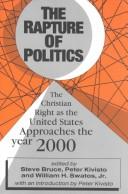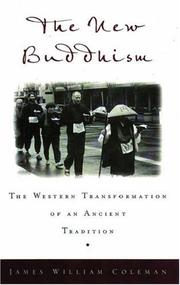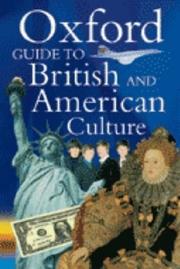| Listing 1 - 10 of 12 | << page >> |
Sort by
|

ISBN: 1560008024 9781560008026 Year: 1994 Publisher: New Brunswick (N. J.): Transaction,
Abstract | Keywords | Export | Availability | Bookmark
 Loading...
Loading...Choose an application
- Reference Manager
- EndNote
- RefWorks (Direct export to RefWorks)
Evangelicalism --- Religious right --- Christianity and politics --- Conservatism --- United States --- christian right --- the year 2000 --- politics --- American culture --- premillennialism

ISBN: 0195152417 0198030169 1280532440 1429404035 0195131622 0199849315 9780195152418 Year: 2002 Publisher: New York: Oxford university press,
Abstract | Keywords | Export | Availability | Bookmark
 Loading...
Loading...Choose an application
- Reference Manager
- EndNote
- RefWorks (Direct export to RefWorks)
In our multicultural society, faiths formerly seen as exotic have become attractive alternatives for many people seeking more satisfying spiritual lives. This is especially true of Buddhism, which is the focus of constant media attention-thanks at least in part to celebrity converts, major motion pictures, and the popularity of the Dalai Lama. Following this recent trend in the West, author James Coleman argues that a new and radically different form of this ancient faith is emerging. The New Buddhism sheds new light on this recent evolution of Buddhist practice in the West. After briefly reco
Buddhism --- Religious life --- Monastic and religious life (Buddhism) --- History --- Buddhism. --- Buddhism - United States - History - 20th century. --- Religious life - Buddhism. --- Monastic and religious life (Buddhism) - United States. --- Western Buddhism --- Asia --- practices --- beliefs --- social structures --- religion --- meditation --- Buddhist groups --- cultural influence --- spiritual appeal --- United States --- American culture --- contemporary spiritual practice --- ethics --- doctrine --- American Buddhism

ISBN: 0194313336 0194313328 9780194313339 9780194313322 Year: 1999 Publisher: Oxford Oxford University Press
Abstract | Keywords | Export | Availability | Bookmark
 Loading...
Loading...Choose an application
- Reference Manager
- EndNote
- RefWorks (Direct export to RefWorks)
Groot-Brittannië --- Verenigde Staten --- Cultuurgeschiedenis. --- History of civilization --- cultuurverschillen --- United States --- Great Britain --- America --- Groot-Brittannië ; cultuurgeschiedenis --- Verenigde Staten ; cultuurgeschiedenis --- Civilization --- Grande-Bretagne --- Etats-Unis --- Dictionaries. --- Civilisation --- Dictionnaires anglais --- Amerika --- Amerikanen --- Britten --- Cultuur --- Dagelijks leven --- Engels --- 995.1 --- 831 Encyclopedische werken --- cultuurgeschiedenis --- #KVHA:Cultuur; Verenigde Staten --- #KVHA:Cultuur; Groot-Brittannie --- Noord-Amerika --- Toerisme --- 914.10/917 --- cultuur --- Groot-Brittannië / Verenigde Staten --- United States of America --- ENGLISH CULTURE --- AMERICAN CULTURE --- DICTIONARY
Book
ISBN: 3030254291 3030254283 9783030254292 9783030254285 Year: 2019 Publisher: Cham : Springer International Publishing : Imprint: Palgrave Macmillan,
Abstract | Keywords | Export | Availability | Bookmark
 Loading...
Loading...Choose an application
- Reference Manager
- EndNote
- RefWorks (Direct export to RefWorks)
This book offers a long overdue, extensive study of one of the most beloved television shows: Friends. Why has this sitcom become the seminal success that it is? And how does it continue to engage viewers around the world a quarter century after its first broadcast? Featuring original interviews with key creative personnel (including co-creator Marta Kauffman and executive producer Kevin S. Bright), the book provides answers by identifying a strategy of intimacy that informs Friends’ use of humour, performance, style and set design. The authors provide fascinating analyses of some of the most well-remembered scenes—the one where Ross can’t get his leather pants back on, and Ross and Rachel’s break-up, to name just a couple—and reflect on how and why A-list guest performances often fell short of the standards set by the ensemble cast. Also considered are the iconic look of Monica’s apartment as well as the programme’s much discussed politics of representation and the critical backlash it has received in recent years. An exploration of Joey, the infamous spin-off, and several attempts to adapt Friends’ successful formula across the globe, round out the discussion, with insights into mistranslated jokes and much more. For students, scholars, creative industry practitioners and fans alike, this is a compelling read that lets us glimpse behind the scenes of what has become a cultural phenomenon and semi-permanent fixture in many of our homes.
Culture—Study and teaching. --- Motion pictures and television. --- Popular Culture. --- United States—Study and teaching. --- Popular Science in Cultural and Media Studies. --- Screen Studies. --- Popular Culture . --- American Culture. --- Culture, Popular --- Mass culture --- Pop culture --- Popular arts --- Communication --- Intellectual life --- Mass society --- Recreation --- Culture --- Moving-pictures and television --- Television and motion pictures --- Television --- Friends (Television program) --- Popular culture. --- Cultural studies --- Study and teaching. --- Popular works --- Motion pictures and television --- Popular culture
Multi
ISBN: 9781137531629 1137531622 1137561963 9781137561961 Year: 2016 Publisher: New York: Palgrave MacMillan,
Abstract | Keywords | Export | Availability | Bookmark
 Loading...
Loading...Choose an application
- Reference Manager
- EndNote
- RefWorks (Direct export to RefWorks)
Bart Beaty and Benjamin Woo work to historicize why it is that certain works or creators have come to define the notion of a "quality comic book," while other works and creators have been left at the fringes of critical analysis.
Sociology of culture --- Didactics of the arts --- Mass communications --- Film --- Literature --- History of civilization --- communicatie --- cultuur --- film --- literatuur --- leren --- Amerikaanse cultuur --- beeldverhalen --- lesgeven --- Spiegelman, Art --- Crumb, Robert --- Satrapi, Marjane --- Kirby, Jack --- Moore, Alan --- Vaughn-James, Martin --- anno 1900-1999 --- anno 2000-2099 --- United States of America --- Communication. --- United States—Study and teaching. --- Film genres. --- Literature, Modern—20th century. --- Literature, Modern—21st century. --- Media and Communication. --- American Culture. --- Genre. --- Contemporary Literature. --- United States. --- Comic books, strips, etc. --- History and criticism.
Book
ISBN: 9780520272446 0520272447 0520283872 0520953657 1283622807 9780520953659 9781283622806 Year: 2012 Volume: 70 Publisher: Berkeley: University of California press,
Abstract | Keywords | Export | Availability | Bookmark
 Loading...
Loading...Choose an application
- Reference Manager
- EndNote
- RefWorks (Direct export to RefWorks)
This book explores the emergence of Greek tragedy on the American stage from the nineteenth century to the present. Despite the gap separating the world of classical Greece from our own, Greek tragedy has provided a fertile source for some of the most innovative American theater. Helene P. Foley shows how plays like Oedipus Rex and Medea have resonated deeply with contemporary concerns and controversies-over war, slavery, race, the status of women, religion, identity, and immigration. Although Greek tragedy was often initially embraced for its melodramatic possibilities, by the twentieth century it became a vehicle not only for major developments in the history of American theater and dance, but also for exploring critical tensions in American cultural and political life. Drawing on a wide range of sources-archival, video, interviews, and reviews-Reimagining Greek Tragedy on the American Stage provides the most comprehensive treatment of the subject available.
Greek drama --- Theater --- History and criticism --- History --- History and criticism. --- History. --- Dramatics --- Histrionics --- Professional theater --- Stage --- Theatre --- Performing arts --- Acting --- Actors --- Greek drama - History and criticism --- Theater - United States - History --- 20th century literacy. --- american culture and politics. --- american interpretation. --- american theater. --- books for english students. --- classical greek literature. --- coffee table books. --- controversial topics. --- dramatic. --- easy to read. --- educational books. --- engaging. --- greek tragedy. --- historical nonfiction. --- history of american dance. --- history of american theater. --- how to write a tragedy. --- intense emotion. --- interpretation of greek tragedy. --- learning while reading. --- lively. --- page turner. --- performing arts. --- shakespeare. --- theater film. --- theatrical.
Book
ISBN: 3319548220 3319548212 9783319548227 3319854933 9783319854939 Year: 2017 Publisher: Basingstoke: Palgrave MacMillan,
Abstract | Keywords | Export | Availability | Bookmark
 Loading...
Loading...Choose an application
- Reference Manager
- EndNote
- RefWorks (Direct export to RefWorks)
This book focuses on the almost entirely neglected treatment of empire and colonialism in videogames. From its inception in the nineties, Game Studies has kept away from these issues despite the early popularity of videogame franchises such as Civilization and Age of Empire. This book examines the complex ways in which some videogames construct conceptions of spatiality, political systems, ethics and society that are often deeply imbued with colonialism. Moving beyond questions pertaining to European and American gaming cultures, this book addresses issues that relate to a global audience – including, especially, the millions who play videogames in the formerly colonised countries, seeking to make a timely intervention by creating a larger awareness of global cultural issues in videogame research. Addressing a major gap in Game Studies research, this book will connect to discourses of post-colonial theory at large and thereby, provide another entry-point for this new medium of digital communication into larger Humanities discourses.
Video games --- Imperialism in popular culture. --- Popular culture --- Television games --- Videogames --- Electronic games --- Research. --- Culture-Study and teaching. --- Ethnology-Europe. --- United States-Study and teaching. --- Humanities-Digital libraries. --- Imperialism. --- Literature . --- Cultural Theory. --- European Culture. --- American Culture. --- Digital Humanities. --- Imperialism and Colonialism. --- Postcolonial/World Literature. --- Belles-lettres --- Western literature (Western countries) --- World literature --- Philology --- Authors --- Authorship --- Colonialism --- Empires --- Expansion (United States politics) --- Neocolonialism --- Political science --- Anti-imperialist movements --- Caesarism --- Chauvinism and jingoism --- Militarism --- Culture—Study and teaching. --- Ethnology—Europe. --- United States—Study and teaching. --- Humanities—Digital libraries. --- postkolonialisme --- videospill --- Imperialism in popular culture --- Video games - Research --- Imperialism --- Literature --- Literature.
Book
ISBN: 331993435X 3319934341 9783319934358 9783030066604 3030066606 Year: 2018 Publisher: Cham, Switzerland: Palgrave MacMillan,
Abstract | Keywords | Export | Availability | Bookmark
 Loading...
Loading...Choose an application
- Reference Manager
- EndNote
- RefWorks (Direct export to RefWorks)
Exploring indigenous life projects in ongoing encounters with extractivism in the Andes and Amazonia, the present open access volume provides ethnographic analyses of indigenous politics, perspectives and worlds. The authors discuss how current turbulences actualise questions of indigeneity, difference and ontological dynamics, examining the reactions (from resistance to mediation of the extralocal), consequences (from anticipation to rubble) and materials (from fossil fuel to water) diversely related to extractivism. How can Amerindian strategies to preserve localised communities in extractivist contexts contribute to ways of thinking otherwise?
Ethnography. --- Ethnology-Latin America. --- Natural resources. --- Environmental policy. --- Ontology. --- Social Structure, Social Inequality. --- Latin American Culture. --- Natural Resources. --- Environmental Policy. --- Environment and state --- Environmental control --- Environmental management --- Environmental protection --- Environmental quality --- State and environment --- Environmental auditing --- National resources --- Natural resources --- Resources, Natural --- Resource-based communities --- Resource curse --- Being --- Philosophy --- Metaphysics --- Necessity (Philosophy) --- Substance (Philosophy) --- Cultural anthropology --- Ethnography --- Races of man --- Social anthropology --- Anthropology --- Human beings --- Government policy --- Economic aspects --- Ethnology --- Social structure. --- Social inequality. --- Ethnology—Latin America. --- Egalitarianism --- Inequality --- Social equality --- Social inequality --- Political science --- Sociology --- Democracy --- Liberty --- Organization, Social --- Social organization --- Social institutions --- Indians of South America - Social conditions --- Natural resources - South America --- Environmental policy - South America --- Social sciences --- Social structure --- Ethnology—Latin America --- Environmental policy --- Ontology --- Indians of South America --- Equality. --- Ethnology.

ISBN: 0691010242 0691028761 0691212724 9780691010243 Year: 1999 Publisher: Princeton (N.J.) : Princeton university press,
Abstract | Keywords | Export | Availability | Bookmark
 Loading...
Loading...Choose an application
- Reference Manager
- EndNote
- RefWorks (Direct export to RefWorks)
Fits, trances, visions, speaking in tongues, clairvoyance, out-of-body experiences, possession. Believers have long viewed these and similar involuntary experiences as religious--as manifestations of God, the spirits, or the Christ within. Skeptics, on the other hand, have understood them as symptoms of physical disease, mental disorder, group dynamics, or other natural causes. In this sweeping work of religious and psychological history, Ann Taves explores the myriad ways in which believers and detractors interpreted these complex experiences in Anglo-American culture between the mid-eighteenth and early-twentieth centuries. Taves divides the book into three sections. In the first, ranging from 1740 to 1820, she examines the debate over trances, visions, and other involuntary experiences against the politically charged backdrop of Anglo-American evangelicalism, established churches, Enlightenment thought, and a legacy of religious warfare. In the second part, covering 1820 to 1890, she highlights the interplay between popular psychology--particularly the ideas of "animal magnetism" and mesmerism--and movements in popular religion: the disestablishment of churches, the decline of Calvinist orthodoxy, the expansion of Methodism, and the birth of new religious movements. In the third section, Taves traces the emergence of professional psychology between 1890 and 1910 and explores the implications of new ideas about the subconscious mind, hypnosis, hysteria, and dissociation for the understanding of religious experience. Throughout, Taves follows evolving debates about whether fits, trances, and visions are natural (and therefore not religious) or supernatural (and therefore religious). She pays particular attention to a third interpretation, proposed by such "mediators" as William James, according to which these experiences are natural and religious. Taves shows that ordinary people as well as educated elites debated the meaning of these experiences and reveals the importance of interactions between popular and elite culture in accounting for how people experienced religion and explained experience. Combining rich detail with clear and rigorous argument, this is a major contribution to our understanding of Protestant revivalism and the historical interplay between religion and psychology.
Psychology, Religious. --- Methodism. --- Experience (Religion) --- Methodism --- Psychology, Religious --- Religious experience --- Psychology of religion --- Religion --- Religions --- Religious psychology --- Psychology and religion --- Arminianism --- Church polity --- Dissenters, Religious --- Episcopacy --- Evangelical Revival --- History --- Psychological aspects --- Psychology --- Buddha. --- Emmanuel Movement. --- Magnet, The (Sunderland). --- New Thought. --- Presbyterians, Scottish. --- Puritanism. --- Quakers. --- Theosophy. --- adepts, theosophical. --- agency, human. --- catalepsy. --- clairvoyance. --- consciousness. --- delusions, religious. --- enthusiasm. --- fluids: magnetic. --- hell. --- imagination. --- inspiration. --- mental weakness. --- nervous instability. --- out-of-body experience. --- psychical research. --- race: and congregational makeup. --- shamanism. --- shekinah. --- temple: as biblical type. --- voices. --- Experience (Religion) - History - 18th century --- Psychology, Religious - History - 18th century --- Methodism - History - 18th century --- Experience (Religion) - History - 19th century --- Psychology, Religious - History - 19th century --- Methodism - History - 19th century --- religious and psychological hsitory --- fits --- trances --- visions --- speaking in tongues --- clairvoyance --- out-of-body experiences --- possession --- religious experience --- Anglo-American culture --- Evangelism --- Enlightenment thought --- religious warfare --- professional psychology --- the subconscious mind --- hypnosis --- hysteria --- dissociation --- supernatural phenomena --- religion and nature --- Protestant revivalism
Book
ISBN: 022630390X 022647819X 9780226478197 9780226303901 9780226164397 022616439X Year: 2015 Publisher: Chicago, Ill.: University of Chicago press,
Abstract | Keywords | Export | Availability | Bookmark
 Loading...
Loading...Choose an application
- Reference Manager
- EndNote
- RefWorks (Direct export to RefWorks)
For many years Chicago's looming large-scale housing projects defined the city, and their demolition and redevelopment-via the Chicago Housing Authority's Plan for Transformation-has been perhaps the most startling change in the city's urban landscape in the last twenty years. The Plan, which reflects a broader policy effort to remake public housing in cities across the country, seeks to deconcentrate poverty by transforming high-poverty public housing complexes into mixed-income developments and thereby integrating once-isolated public housing residents into the social and economic fabric of the city. But is the Plan an ambitious example of urban regeneration or a not-so-veiled effort at gentrification? In the most thorough examination of mixed-income public housing redevelopment to date, Robert J. Chaskin and Mark L. Joseph draw on five years of field research, in-depth interviews, and volumes of data to demonstrate that while considerable progress has been made in transforming the complexes physically, the integrationist goals of the policy have not been met. They provide a highly textured investigation into what it takes to design, finance, build, and populate a mixed-income development, and they illuminate the many challenges and limitations of the policy as a solution to urban poverty. Timely and relevant, Chaskin and Joseph's findings raise concerns about the increased privatization of housing for the poor while providing a wide range of recommendations for a better way forward.
Mixed-income housing - Illinois - Chicago --- Inclusionary housing programs - Illinois - Chicago --- Community development - Illinois - Chicago --- Social integration - Illinois - Chicago --- Logement à revenu mixte --- Programme de logement inclusif --- Développement communautaire urbain --- Intégration sociale --- Illinois --- Chicago --- Mixed-income housing --- Inclusionary housing programs --- Community development --- Social integration --- Chicago Housing Authority. --- Inclusion, Social --- Integration, Social --- Social inclusion --- Sociology --- Belonging (Social psychology) --- Regional development --- Economic assistance, Domestic --- Social planning --- Housing programs, Inclusionary --- Housing policy --- Low-income housing --- Zoning --- Housing --- Citizen participation --- Government policy --- public housing, mixed income neighborhoods, inner city, cities, urban areas, social services, chicago, illinois, united states of america, american culture, usa, redevelopment, poverty, gentrification, privatization, inclusionary, transformation plan, community development, interactions, engagement, surveillance, civic life, integration, regulation, policy orientations.
| Listing 1 - 10 of 12 | << page >> |
Sort by
|

 Search
Search Feedback
Feedback About UniCat
About UniCat  Help
Help News
News